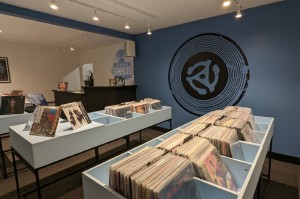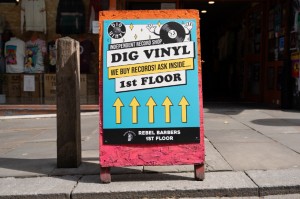I Want My MTV

The Art of Pop Video exhibition at FACT awakens memories of a transformative period for Amy Roberts…
Everyone goes through those childhood obsessions with collections. The idea of amassing something, proudly showing it off in the schoolyard and hunting for those rare, hard to find items to complete the set is an experience most of us share.
My particular obsessions varied. Beginning with Polly Pockets that I always brought to, and lost, in school; a stamp collection I abandoned because, well, yawn, and the football stickers I accumulated just so the boys would let me kick a ball around with them (I remember trading my precious Patrik Berger sticker one day so I didn’t have to play in goal).
On hitting 13 I had a revelation. Whilst watching the US Top 20 one day with my dad, a video came on that had me immediately and utterly beguiled. The song was Fast As You Can by Fiona Apple (directed by her then boyfriend Paul Thomas Anderson), and the image of this winsome, unkempt waif moving her mouth impassively out of sync to the lyrics of her disjointed, jazz wrought song provoked a fascination in me that endures to this day.
Nobody at school had a clue who or what I was talking about. They didn’t have the same music channel privileges my household did (my parents replaced their avid attendance at local gigs with a music package from Sky); I was adamant that they see it. I sat transfixed by the TV for days waiting for the video to be shown again, a blank VHS loaded up in the VCR. Waiting with remote control in hand, I developed gunslinger-like reflexes, pressing record at the very beginning of videos that I treasured more than those Polly Pockets, stamps and football stickers put together (even Patrik Berger).
This practice eventually produced a small collection of VHS tapes that varied from the comedic to the stunning, artsy to angsty – some so rarely shown that I’d near break my neck to capture them. At weekends me and my friends would sit around and pile through them, hungrily consuming images and music the way teenage girls do now on Tumblr. The videos were vital to us, not just for discovering new music or drooling over idols (as nascent teen hormones kicked in), but in inspiring us with art, photography and filmmaking, and informing personal identity.
It was gratifying to discover too that there were women in music who didn’t just amount to a pile of pleasant flesh jiggling about in crop tops, but that they had strong ideas and convictions that translated to our own, and a sense of strength, creativity and defiance that was truly inspiring. From Courtney Love smearing make up over her face and screaming in a truly unpretty way in the video for Violet by Hole, to PJ Harvey with her overgrown eyebrows, off-kilter mannerisms and commentary on gender politics in the Maria Mochnacz directed video for Man-Size, we developed an appreciation for our own awkward femininity. We finally felt as though we belonged.
We watched videos that felt as though somebody had opened our brain and poured phantasmagorical sonic lightbulbs in (bing!), the work of Michel Gondry and Chris Cunningham absolutely blowing our minds and reconfiguring our ideas on the possibilities of art.
The flexibility of Gondry’s constantly mutating set pieces and playfulness of character (like the never ending, fantastical replications of Bjork’s tabloid presence in Bachelorette and Daft Punk’s Around The World jiving off the screen like a rave co-curated by Fred Astaire and Hanna Barbera) showed us the simplicity of invention. Whilst Chris Cunningham’s nightmarish work with Aphex Twin (lovingly recorded by my dad late one night, who obviously understood the hellish curiosities of a teenage girl’s brain) just plain scared the shit out of us in a way we would never have thought dance music capable of (walking past the 051 late on a Saturday night excepted).
These VHS tapes fast became prized possessions. I spent entire evenings cutting and pasting intricate collages onto the covers that in some way expressed the nuances of the work held within. They were a diminutive art collection; an entire and portable home gallery curated by myself that expressed concepts I wasn’t yet up to the challenge of articulating myself.
Within a short space of time, music videos became far more accessible to everyone, my tapes made redundant faced with multiple programs and channels suddenly available to anyone with a TV. Entire collections of music videos, from musicians, record labels and even music video directors, became available for purchase. Some CD releases even had videos embedded onto the discs that people could play on their PC.
Before long even kids who laughed in the face of artistic expression or a penchant for pop culture, were referencing the Spike Jonze video for Weezer’s Buddy Holly, or Rammstein’s take on Snow White in their release for Sonne. Ironically, even videos that had previously given us misfit kids a vehicle with which to communicate our awkward, individual personalities got used against us, and something like Aphex Twin became the scally insult du jour hurled at girls who, apparently, resembled a gawky, grimacing Richard D. James figure in a frock (kids are so cruel).
Music channels realised the quick commodification of videos and moved on accordingly, increasingly giving screen time to cartoons and cheap reality shows. I moved on too. Before long most of those VHS tapes got filled up with episodes of Daria, or Christian Slater movies recorded late night off Channel 4 (I regret nothing). Now of course you encounter music videos at just about every turn, regardless of whether you actively want to see Rihanna half clothed gyrating on a beach or not. From the priciest of bars to the scummiest of chippies, music videos run a kind of background quasi babysitting service for the easily distracted.
The music video has become the new boom box to any kid with a device fast enough to stream through the endless libraries available to them. Their ephemeral gallery spaces set up on street corners and on the top decks of buses. It’s comforting to think that my teenage obsession exists still, and in an online and technological realm that broadens the scope of reach and possibilities of communication.
Because back then, with those VHS tapes, we had the sense that art could be ours, too. It didn’t just belong in a stuffy gallery somewhere that would probably throw us out for being young and loud, it belonged here with us and as loud as we wanted it to be. We were vivid, lucid, plural and above all, we had the shared voice and visual of hundreds of videos that not only felt as though they spoke directly to us, but also spoke it back out to the rest of a World we felt may never have understood us otherwise.
Amy Roberts
The Art of Pop Video continues at Fact until 26th May





